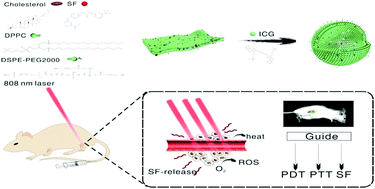Sorafenib and indocyanine green co-loaded in photothermally sensitive liposomes for diagnosis and treatment of advanced hepatocellular carcinoma†
Abstract
Sorafenib (SF), as an irreplaceable first-line drug to help advanced hepatocellular carcinoma (HCC) patients to prolong their lives, has already been used in clinical practice for several years. However, this treatment causes several side effects, and few alternatives to SF treatment exist. Herein, we designed NIR fluorescence imaging-guided photothermally sensitive nanoliposomes based on co-encapsulation of SF and the clinical photothermal and photodynamic therapy agent Indocyanine Green (ICG) to solve the problems of SF-based treatment in advanced HCC. As expected, in vitro and in vivo drug release studies on SF–ICG liposomes (SILs) demonstrated SF release from SILs compared with free SF at the same concentration. In addition, in vivo NIR fluorescence imaging and anti-tumor treatment using SILs have been demonstrated by using Hep3B tumor-bearing xenograft nude mice. All detailed experimental evidence suggested that biocompatibility, biotoxicity, and anti-tumor effects were improved by using SILs instead of free SF. In conclusion, our designed SILs could present a novel and suitable SF-based treatment strategy for advanced HCC therapy in the future.



 Please wait while we load your content...
Please wait while we load your content...